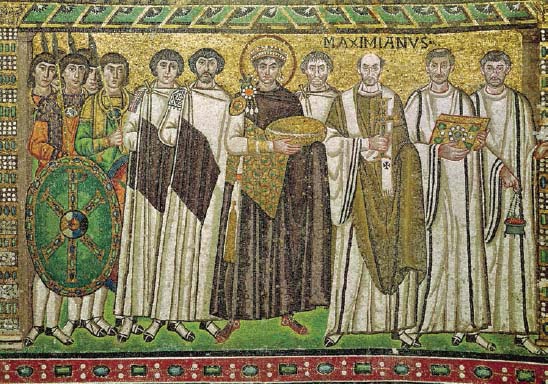The Medieval World, C. 400–1300Byzantine Art |
Who was Emperor Justinian? |
Emperor Justinian was one of the most powerful and important rulers of the early Byzantine Empire and was responsible for large-scale building projects centered in the city of Constantinople, and in Byzantine territories in Italy. The Church of San Vitale in Ravenna, on the eastern coast of Italy, contains large mosaics dedicated to Justinian.
Completed around 547 C.E. and placed in a central location in the church, Emperor Justinian and His Attendants is one of the most impressive Byzantine mosaic from the period, and features realistically-modeled figures composed against a golden background and framed within an abstract, geometric pattern of glass tile. The haloed figure of Justinian is in the center, flanked by his ecclesiastical personnel on his left, and both civil and military personnel on his right. The soldiers are grouped behind a large shield decorated with the Greek letters “XP,” representing Christ. The church officials on his right hold a jeweled cross and a gospel book. Wearing long purple robes that indicate his power (and visually align him with images of Christ), Justinian wears ornate crown jewels and carries a vessel containing bread for the Mass held in the church. Against the glittering gold background, it is as if the Emperor and his attendants hover in a detached, spiritual realm. Emperor Justinian is clearly in charge of this far flung Byzantine outpost, even if he never actually visited Ravenna during his lifetime.

The powerful Byzantine emperor Justinian is depicted in a sixth-century mosaic, along with his stoic attendants, in the Church of San Vitale in Ravenna, Italy. The mosaic was an important form of art in the Roman, Byzantine, and Islamic empires.
